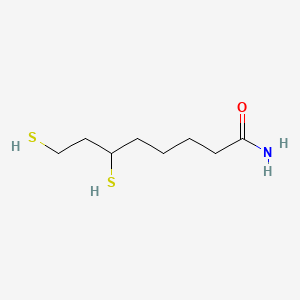| MeSH term | MeSH ID | Detail |
|---|---|---|
| Parkinsonian Disorders | D020734 | 20 associated lipids |
Dihydrolipoamide
Dihydrolipoamide is a lipid of Fatty Acyls (FA) class. Dihydrolipoamide is associated with abnormalities such as Wiskott-Aldrich Syndrome. The involved functions are known as Citric Acid Cycle, Electron Transport, NADH oxidation, Oxidation and Oxidants. Dihydrolipoamide often locates in Mitochondria, Mitochondrial matrix and Chloroplasts. The associated genes with Dihydrolipoamide are Mutant Proteins, Recombinant Proteins, mycothione reductase, Genes, Mitochondrial and alanylproline.
Cross Reference
Introduction
To understand associated biological information of Dihydrolipoamide, we collected biological information of abnormalities, associated pathways, cellular/molecular locations, biological functions, related genes/proteins, lipids and common seen animal/experimental models with organized paragraphs from literatures.
What diseases are associated with Dihydrolipoamide?
Dihydrolipoamide is suspected in and other diseases in descending order of the highest number of associated sentences.
Related references are mostly published in these journals:
| Disease | Cross reference | Weighted score | Related literature |
|---|
Possible diseases from mapped MeSH terms on references
We collected disease MeSH terms mapped to the references associated with Dihydrolipoamide
PubChem Associated disorders and diseases
What pathways are associated with Dihydrolipoamide
There are no associated biomedical information in the current reference collection.
PubChem Biomolecular Interactions and Pathways
Link to PubChem Biomolecular Interactions and PathwaysWhat cellular locations are associated with Dihydrolipoamide?
Visualization in cellular structure
Associated locations are in red color. Not associated locations are in black.
Related references are published most in these journals:
| Location | Cross reference | Weighted score | Related literatures |
|---|
What functions are associated with Dihydrolipoamide?
Related references are published most in these journals:
| Function | Cross reference | Weighted score | Related literatures |
|---|
What lipids are associated with Dihydrolipoamide?
There are no associated biomedical information in the current reference collection.
What genes are associated with Dihydrolipoamide?
Related references are published most in these journals:
| Gene | Cross reference | Weighted score | Related literatures |
|---|
What common seen animal models are associated with Dihydrolipoamide?
There are no associated biomedical information in the current reference collection.
NCBI Entrez Crosslinks
All references with Dihydrolipoamide
Download all related citations| Authors | Title | Published | Journal | PubMed Link |
|---|---|---|---|---|
| Stöckel J et al. | Diurnal rhythms result in significant changes in the cellular protein complement in the cyanobacterium Cyanothece 51142. | 2011 | PLoS ONE | pmid:21364985 |
| Phillips NJ et al. | Proteomic analysis of Neisseria gonorrhoeae biofilms shows shift to anaerobic respiration and changes in nutrient transport and outermembrane proteins. | 2012 | PLoS ONE | pmid:22701624 |
| Sandoval JM et al. | Glucose-6-phosphate dehydrogenase protects Escherichia coli from tellurite-mediated oxidative stress. | 2011 | PLoS ONE | pmid:21984934 |
| Wang N et al. | Display of Bombyx mori alcohol dehydrogenases on the Bacillus subtilis spore surface to enhance enzymatic activity under adverse conditions. | 2011 | PLoS ONE | pmid:21738670 |
| Hakansson AP et al. | Apoptosis-like death in bacteria induced by HAMLET, a human milk lipid-protein complex. | 2011 | PLoS ONE | pmid:21423701 |
| Sianglum W et al. | Proteome analyses of cellular proteins in methicillin-resistant Staphylococcus aureus treated with rhodomyrtone, a novel antibiotic candidate. | 2011 | PLoS ONE | pmid:21326597 |
| Marques B et al. | Liposome-mediated cellular delivery of active gp91(phox). | 2007 | PLoS ONE | pmid:17848987 |
| Viadas C et al. | Transcriptome analysis of the Brucella abortus BvrR/BvrS two-component regulatory system. | 2010 | PLoS ONE | pmid:20422049 |
| Mochel F et al. | Early energy deficit in Huntington disease: identification of a plasma biomarker traceable during disease progression. | 2007 | PLoS ONE | pmid:17653274 |
| Skapski A et al. | Genome-scale analysis of Mycoplasma agalactiae loci involved in interaction with host cells. | 2011 | PLoS ONE | pmid:21966487 |
